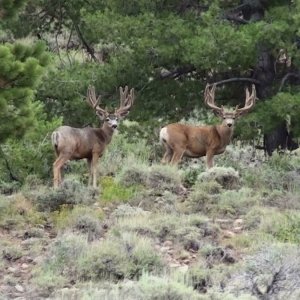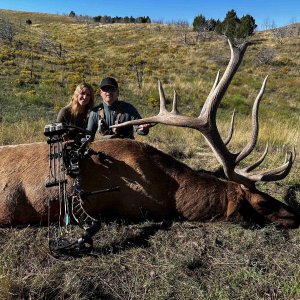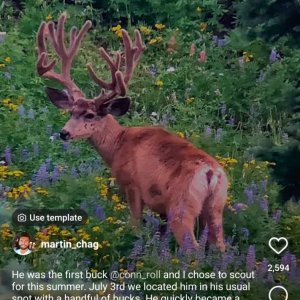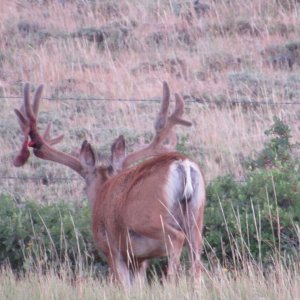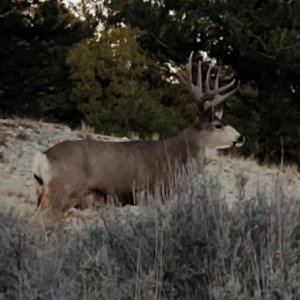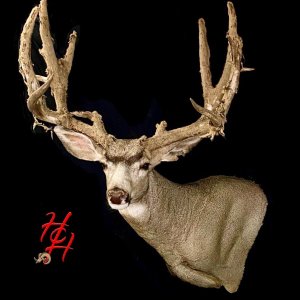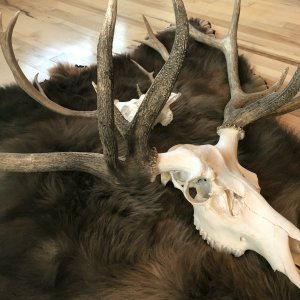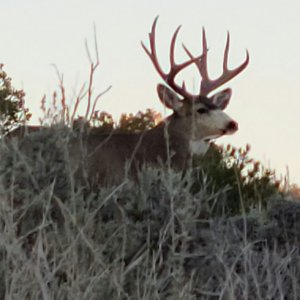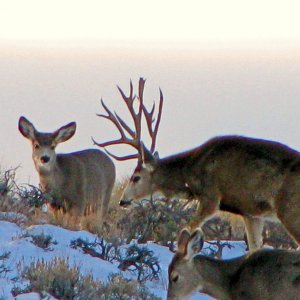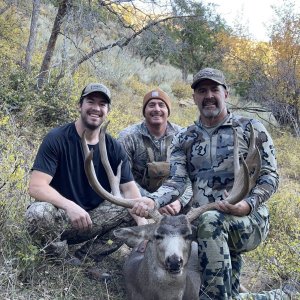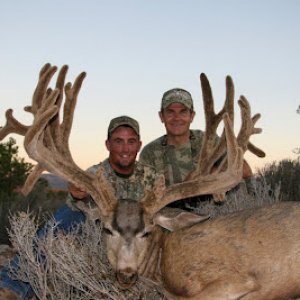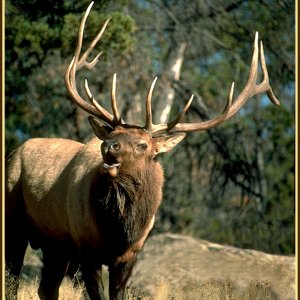... so i wrote this research paper for school... Here it is, tell me what you think.\
Since my first hunting excursion, when I was 5 years of age, I have been interested and intrigued by mule deer antlers. I remember hearing my father, and his brother, my uncle Kevin talking about some really large bucks they had seen here in Oregon, or in Wyoming and Colorado. I liked to sit and listen to them embellish the facts about the good old days of hunting, when shooting a buck with a 35 inch wide spread was not the most uncommon of experiences. Several years ago my uncle Kevin received a book for Christmas entitled Wyoming?s Finest Mule Deer. This book further sparked my interest in mule deer bucks, due to the pictures of some monstrous bucks found in the book. Some of the most famous bucks have even been named, such ass Popeye, or Morty. Popeye who was watched by the hunting community for many a year, was one of the largest mule deer bucks ever to live. A hunter never killed him. As one of the most famous bucks ever, Popeye inspired me in many ways to get interested in hunting mule deer. I have often wondered what makes the biggest bucks have such large antlers, and why some areas produce larger bucks than others. I have always wanted to know why the state of Oregon produces very few record book bucks, whereas Wyoming, Colorado, Nevada, and Utah produce huge bucks on a regular basis. Through my own research, magazine articles, and conversations with longtime hunters, I have come to the conclusion that there are many, many factors involved in producing big mature bucks, and genetics is one of these factors I have long been trying to uncover some of these questions. For years I have wanted to know what makes big bucks big, and what makes some areas produce bigger bucks than others. And I was finally presented with an opportunity to do some research on these specific questions. In my research I have delved deep into the recesses of knowledge of one of the foremost researchers of mule deer behavior and ecology, Dr. Velerius Geist, He presents several thesis?s and theories about mule deer antler growth in his book Mule Deer Country, along with hard proven facts. I found that although many books are written on mule deer, and their behavior, very few refer to genetics, or even antler growth as a whole. After searching long and hard, I did find the sources needed to support my thesis. Genetics play an important role mule deer reproduction, and the growth and development and antlers.
Since the foundation of the Boone and Crockett club by former president Theodore Roosevelt in the early part of the 20th century, the clubs scoring system has been used as a standard for measurement of mule deer antlers. There are two categories in this measurement system, typical, and non-typical. The typical category is for just that, typical bucks, meaning bucks carrying a ?typical? set of antlers, with a 4 point bifurcated frame (see figures A,B,C). The non-typical category is reserved for the most abnormal bucks, those with very unique racks. (see figure d) For a typical buck there are 13 measuring points, all measured in inches. The scoring system uses the following measurements to find a total Boone and Crocket Score:
Scoring System
A. Number of points
B. Tip to tip spread
C. Greatest spread
D. Inside spread of main-beams
E. Total length of abnormal points
F. Length of main beams
G-1. Length of first point
G-2. Length of second point
G-3. Length of third point
G-4. Length of fourth point
H-1. Circumference of smallest place between burr and first point
H-2. Circumference of smallest place between first and second point
H-3. Circumference of smallest place between main beam and third point
H-4. Circumference at smallest place between second and fourth points
All measurements are made with a 1/4 inch flexible steel tape, and are to the nearest 1/8th of an inch. Total measurements of the left antler, are added to the total measurements of the right antler, and the total differences between right and left are deducted. Non-typical measurements are same, but do not include deduction for abnormal points. The minimum requirement for a buck too be listed in the all time record book is 190 or more inches. (boone 1) For a buck to get this large takes great genetics, and an ideal environment.
?Antler development is important for establishing dominance among males, and gaining access to mates.? (ditchkoff 616) To a mule deer buck, nothing is more important than large antlers, they can provide dominance over smaller males, and attract females. Males advertise good genetics through sexual ornamentation and display. Female Mate choice is based on sexual ornamentation, and the bigger a bucks antlers are, the more does he will have a chance to breed with. (ditchkoff 617) Does want big bucks with large antlers, because those traits will be passed on to her fawn, making it more likely to survive longer, and giving it a better chance at reproduction. Antler size and mass reflect a buck?s survivor capability. Large antlers mean that particular buck was better at obtaining proper substances to support his fast growing antlers, so not his large antlers are passed on to his fawn, as are his ability to gather necessary substances for growth. ?The fathers ability to spare resources from growth express itself as large antlers, because antlers are universally highly sensitive to forage surpluses.? (geist 73) Antler characteristics are readily heritable, along with shape, but size and mass are not. (suttie 379, evenden 520)
There are many substances found in antlers, the most prominent being the following: Protein, collagen, lipids, uronic acid, sulfate acid, sialilic acid, ash, calcium, phosphorus, and magnesium. In a study of the chemical composition of different sections of antlers, it was found that ash content was lowest in tip, and highest in base; lipids and proteins were highest in tip and lowest in base; all minerals associated with calcification were highest in base and lowest in tip. (suttie 379)
There is a definite correlation between antler size and body weight. (evenden 521) According to Dr. Geist, the larger the antlers of a breeding buck, the larger the birth weight of the fawn will be, another reason bucks with large antlers are more sexually attractive than those with small. (geist 73) According to Evenden, there is a definite tendency for the right beam to be larger than the left. Brow tines are thought to be found only on the healthiest bucks, with the best genetics.
Genetics often dictate the form in which an old mature buck?s antler form. Each winter, after breeding is through, a buck cast his antlers, soon after casting, or shedding, his antlers grow all over again. During growth, they are covered in one of the fastest growing tissues in the animal world, a soft hairy skin-like covering known as velvet. During this cycle of growth, loss, and regrowth many changes can take place from year to year. Antler development of yearlings may reflect winter nutritional levels. (evenden 521) Some bucks vary very little from one year to the next. (geist 103) There is a well known theory that old bucks often regress in antler growth. According to Dr. Geist, buck?s antler grow regularly larger, and longer for up to 8 years, then begin a cycle of regression. ?Antlers become more asymmetrical, and smaller, until the buck returns with only two long wavy spikes.? (geist 103) Big, aging mule deer bucks have large regressed antlers, with lots of mass, and long points. If the buck had a large four point frame, he might revert back to a two or three point frame. Undernutrion for long periods of time, can, and does inhibit antler growth, after a long hard winter, such as the winter of 1992-1993, can cause buck to grow thin antlers, with less mass.
Some areas have better genetics, and a potential for bigger bucks than other areas. Some of the largest most respected bucks have come from this area. Wyoming has long been known for producing huge bucks, both typical and non-typical. Some of the bucks that have come from Wyoming?s region ?G? have set the par for trophy mule deer. The world record mule deer, shot in Colorado in the 1960?s, came from one of the best producing areas in the country. All bucks are not the same. According to Dr. Geist, some bucks just cannot get big, in certain areas, the largest bucks have only a 2 pt frame, but with large spread, while other areas produce mostly 4 point, or abnormal, non-typical frames. The tendency for bucks to have lots of points can also be in isolated areas (see figure E). Through my own research and experiences, I have concluded that the bucks in this part of northeastern Oregon, there is a definite tendency for bucks to carry lots of points, and lots of mass, but not spread or tine length. From observing bucks on winter range, and in areas where bucks are relatively tame, and fearless of human contact, I have observed that may bucks here have long main beams, and are tall, but there are very few exceptionally wide bucks, or bucks with long points and deep forks. According to Suttie, scientist have been able to isolate 2 different alleles that affect antler growth and development in different ways. One of these alleles affects tine length, meaning that, bucks can pass on short tines, or long tines.
After all this time consuming research, I have learned one thing: There are exceptions to every rule. Things are not always as they seem. I learned that genetics do play a large role in antler growth and development, but not nearly as large of a role as I originally suspected. When I first started looking for sources on mule deer genetics, Mrs. Woodward the librarian, along with Mrs. Turner, pointed me in the right direction time and time again. I found that www.monstermuleys.com, and people on that site were one of the most helpful places in finding sources. I heard from several people that books by Dr. Valerius Geist would be very helpful. After hearing this, I logged onto Amazon. com and purchased two books by the named author. Although due to shipping problems one of them was not delivered, I found the other to be one of the most helpful sources used on this paper. Last year, while digging through some old papers, and books on wildlife, I came across a compilation of research papers call the journal of wildlife management. Inside this journal, I found a study on mule deer antler morphology. Although written in 1969, it presented some very prevalent points, that I found very helpful throughout the process of writing this paper. Early into this project, after finding only these two sources, and needing 3-5 more, I began to panic. After staying up till midnight several nights in a row searching the depths of the supposedly endless Internet, I came across two well-written research papers. Although such a long title may make it seem a little intimidating, ?Studies of Antler Growth: A review of Literature? I found it to be easy to understand, and overall quite helpful. With an even more intimidating title ?Major Histocompatabilty-Complex- Associated Variation in Secondary Sexual Traits of White-tailed Deer, Evidence for Good Genes Advertisement? was extremely helpful and very, very appreciated. My last, but defiantly not least source was the Boone and Crocket Clubs official website. I was able to download, and use a PDF that was used to list all the measurement requirements for a record book entry. I also used it to list the differences between the typical and non-typical categories of the Boone and Crockett clubs record book. The website also helped me to list the minimum requirement for the record book. Although this project required me expend a lot more effort than I am used to. I found out what I set out too, and will walk away well satisfied.
Later Yall!!!!
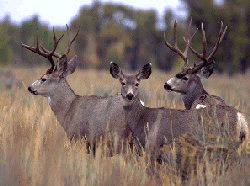
Since my first hunting excursion, when I was 5 years of age, I have been interested and intrigued by mule deer antlers. I remember hearing my father, and his brother, my uncle Kevin talking about some really large bucks they had seen here in Oregon, or in Wyoming and Colorado. I liked to sit and listen to them embellish the facts about the good old days of hunting, when shooting a buck with a 35 inch wide spread was not the most uncommon of experiences. Several years ago my uncle Kevin received a book for Christmas entitled Wyoming?s Finest Mule Deer. This book further sparked my interest in mule deer bucks, due to the pictures of some monstrous bucks found in the book. Some of the most famous bucks have even been named, such ass Popeye, or Morty. Popeye who was watched by the hunting community for many a year, was one of the largest mule deer bucks ever to live. A hunter never killed him. As one of the most famous bucks ever, Popeye inspired me in many ways to get interested in hunting mule deer. I have often wondered what makes the biggest bucks have such large antlers, and why some areas produce larger bucks than others. I have always wanted to know why the state of Oregon produces very few record book bucks, whereas Wyoming, Colorado, Nevada, and Utah produce huge bucks on a regular basis. Through my own research, magazine articles, and conversations with longtime hunters, I have come to the conclusion that there are many, many factors involved in producing big mature bucks, and genetics is one of these factors I have long been trying to uncover some of these questions. For years I have wanted to know what makes big bucks big, and what makes some areas produce bigger bucks than others. And I was finally presented with an opportunity to do some research on these specific questions. In my research I have delved deep into the recesses of knowledge of one of the foremost researchers of mule deer behavior and ecology, Dr. Velerius Geist, He presents several thesis?s and theories about mule deer antler growth in his book Mule Deer Country, along with hard proven facts. I found that although many books are written on mule deer, and their behavior, very few refer to genetics, or even antler growth as a whole. After searching long and hard, I did find the sources needed to support my thesis. Genetics play an important role mule deer reproduction, and the growth and development and antlers.
Since the foundation of the Boone and Crockett club by former president Theodore Roosevelt in the early part of the 20th century, the clubs scoring system has been used as a standard for measurement of mule deer antlers. There are two categories in this measurement system, typical, and non-typical. The typical category is for just that, typical bucks, meaning bucks carrying a ?typical? set of antlers, with a 4 point bifurcated frame (see figures A,B,C). The non-typical category is reserved for the most abnormal bucks, those with very unique racks. (see figure d) For a typical buck there are 13 measuring points, all measured in inches. The scoring system uses the following measurements to find a total Boone and Crocket Score:
Scoring System
A. Number of points
B. Tip to tip spread
C. Greatest spread
D. Inside spread of main-beams
E. Total length of abnormal points
F. Length of main beams
G-1. Length of first point
G-2. Length of second point
G-3. Length of third point
G-4. Length of fourth point
H-1. Circumference of smallest place between burr and first point
H-2. Circumference of smallest place between first and second point
H-3. Circumference of smallest place between main beam and third point
H-4. Circumference at smallest place between second and fourth points
All measurements are made with a 1/4 inch flexible steel tape, and are to the nearest 1/8th of an inch. Total measurements of the left antler, are added to the total measurements of the right antler, and the total differences between right and left are deducted. Non-typical measurements are same, but do not include deduction for abnormal points. The minimum requirement for a buck too be listed in the all time record book is 190 or more inches. (boone 1) For a buck to get this large takes great genetics, and an ideal environment.
?Antler development is important for establishing dominance among males, and gaining access to mates.? (ditchkoff 616) To a mule deer buck, nothing is more important than large antlers, they can provide dominance over smaller males, and attract females. Males advertise good genetics through sexual ornamentation and display. Female Mate choice is based on sexual ornamentation, and the bigger a bucks antlers are, the more does he will have a chance to breed with. (ditchkoff 617) Does want big bucks with large antlers, because those traits will be passed on to her fawn, making it more likely to survive longer, and giving it a better chance at reproduction. Antler size and mass reflect a buck?s survivor capability. Large antlers mean that particular buck was better at obtaining proper substances to support his fast growing antlers, so not his large antlers are passed on to his fawn, as are his ability to gather necessary substances for growth. ?The fathers ability to spare resources from growth express itself as large antlers, because antlers are universally highly sensitive to forage surpluses.? (geist 73) Antler characteristics are readily heritable, along with shape, but size and mass are not. (suttie 379, evenden 520)
There are many substances found in antlers, the most prominent being the following: Protein, collagen, lipids, uronic acid, sulfate acid, sialilic acid, ash, calcium, phosphorus, and magnesium. In a study of the chemical composition of different sections of antlers, it was found that ash content was lowest in tip, and highest in base; lipids and proteins were highest in tip and lowest in base; all minerals associated with calcification were highest in base and lowest in tip. (suttie 379)
There is a definite correlation between antler size and body weight. (evenden 521) According to Dr. Geist, the larger the antlers of a breeding buck, the larger the birth weight of the fawn will be, another reason bucks with large antlers are more sexually attractive than those with small. (geist 73) According to Evenden, there is a definite tendency for the right beam to be larger than the left. Brow tines are thought to be found only on the healthiest bucks, with the best genetics.
Genetics often dictate the form in which an old mature buck?s antler form. Each winter, after breeding is through, a buck cast his antlers, soon after casting, or shedding, his antlers grow all over again. During growth, they are covered in one of the fastest growing tissues in the animal world, a soft hairy skin-like covering known as velvet. During this cycle of growth, loss, and regrowth many changes can take place from year to year. Antler development of yearlings may reflect winter nutritional levels. (evenden 521) Some bucks vary very little from one year to the next. (geist 103) There is a well known theory that old bucks often regress in antler growth. According to Dr. Geist, buck?s antler grow regularly larger, and longer for up to 8 years, then begin a cycle of regression. ?Antlers become more asymmetrical, and smaller, until the buck returns with only two long wavy spikes.? (geist 103) Big, aging mule deer bucks have large regressed antlers, with lots of mass, and long points. If the buck had a large four point frame, he might revert back to a two or three point frame. Undernutrion for long periods of time, can, and does inhibit antler growth, after a long hard winter, such as the winter of 1992-1993, can cause buck to grow thin antlers, with less mass.
Some areas have better genetics, and a potential for bigger bucks than other areas. Some of the largest most respected bucks have come from this area. Wyoming has long been known for producing huge bucks, both typical and non-typical. Some of the bucks that have come from Wyoming?s region ?G? have set the par for trophy mule deer. The world record mule deer, shot in Colorado in the 1960?s, came from one of the best producing areas in the country. All bucks are not the same. According to Dr. Geist, some bucks just cannot get big, in certain areas, the largest bucks have only a 2 pt frame, but with large spread, while other areas produce mostly 4 point, or abnormal, non-typical frames. The tendency for bucks to have lots of points can also be in isolated areas (see figure E). Through my own research and experiences, I have concluded that the bucks in this part of northeastern Oregon, there is a definite tendency for bucks to carry lots of points, and lots of mass, but not spread or tine length. From observing bucks on winter range, and in areas where bucks are relatively tame, and fearless of human contact, I have observed that may bucks here have long main beams, and are tall, but there are very few exceptionally wide bucks, or bucks with long points and deep forks. According to Suttie, scientist have been able to isolate 2 different alleles that affect antler growth and development in different ways. One of these alleles affects tine length, meaning that, bucks can pass on short tines, or long tines.
After all this time consuming research, I have learned one thing: There are exceptions to every rule. Things are not always as they seem. I learned that genetics do play a large role in antler growth and development, but not nearly as large of a role as I originally suspected. When I first started looking for sources on mule deer genetics, Mrs. Woodward the librarian, along with Mrs. Turner, pointed me in the right direction time and time again. I found that www.monstermuleys.com, and people on that site were one of the most helpful places in finding sources. I heard from several people that books by Dr. Valerius Geist would be very helpful. After hearing this, I logged onto Amazon. com and purchased two books by the named author. Although due to shipping problems one of them was not delivered, I found the other to be one of the most helpful sources used on this paper. Last year, while digging through some old papers, and books on wildlife, I came across a compilation of research papers call the journal of wildlife management. Inside this journal, I found a study on mule deer antler morphology. Although written in 1969, it presented some very prevalent points, that I found very helpful throughout the process of writing this paper. Early into this project, after finding only these two sources, and needing 3-5 more, I began to panic. After staying up till midnight several nights in a row searching the depths of the supposedly endless Internet, I came across two well-written research papers. Although such a long title may make it seem a little intimidating, ?Studies of Antler Growth: A review of Literature? I found it to be easy to understand, and overall quite helpful. With an even more intimidating title ?Major Histocompatabilty-Complex- Associated Variation in Secondary Sexual Traits of White-tailed Deer, Evidence for Good Genes Advertisement? was extremely helpful and very, very appreciated. My last, but defiantly not least source was the Boone and Crocket Clubs official website. I was able to download, and use a PDF that was used to list all the measurement requirements for a record book entry. I also used it to list the differences between the typical and non-typical categories of the Boone and Crockett clubs record book. The website also helped me to list the minimum requirement for the record book. Although this project required me expend a lot more effort than I am used to. I found out what I set out too, and will walk away well satisfied.
Later Yall!!!!


